Wormwood Scrubs, Hammersmith, London
On 19 December 1874, construction began of a large new convict prison at Wormwood Scrubs, then a large area of open parkland at the north of Hammersmith, in west London.
Its architect was Sir Edmund Frederick Du Cane, a Major-General in the Royal Engineers and Chairman of the Commissioners of Prisons. His design adopted what became known as a 'telegraph-pole' plan, with detached pavilions linked by a covered passageway. The layout derived from pavilion-plan hospitals of the period, whose use had been promoted by Florence Nightingale. Wormwood Scrubs had four parallel cell blocks, all four storeys in height and oriented north-south. The blocks, which included projecting sanitary towers, were linked at their centres by a single-storey ground-floor corridor. Between the wings were exercise yards and separate buildings housing kitchens, bath-houses, laundry and chapel. Further buildings, such as workshops, stores, hospitals, offices, receptions and the entrance gateway were placed at the south of the site, alongside which ran what became Du Cane Road. The towers on each side of the entrance gateway contained terra-cotta medallions of prison reformers John Howard and Elizabeth Fry.
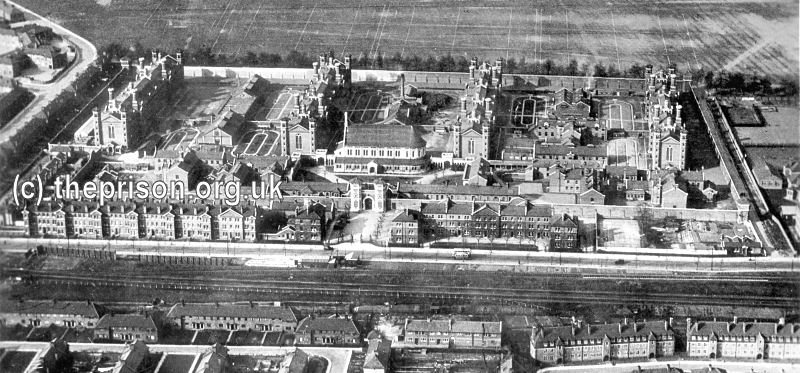
Wormwood Scrubs Prison - aerial view from the south, London. © Peter Higginbotham
Construction plans for the building are said to have been drawn out by a convict in his cell while undergoing the probationary nine months to a long term of imprisonment. The man was originally an architect, and among the foremost in his profession. The completion of the work, on a sheet measuring 5 ft. 3 ins. by 5 ft. 6 ins., occupied him for nearly six months.
The building work was carried out by convict labour. At the outset, a team of nine specially selected convicts, all of good character and within a year of their release, erected a temporary corrugated iron prison, with a wall one brick thick and a surrounding fence with wooden gates. Another shed provided lodging and kitchens for the warder staff. On 5 May 1875, accommodation had been created for 195 prisoners, although only 97 were then in custody. The work proceeded steadily but slowly, only being fully completed in 1890. Bricks for the buildings were manufactured on site, with 35 million eventually being produced, some of which were sent elsewhere. Much of the other construction materials were sourced from other convict prisons: iron castings and Portland stone from Portland, and granite from Dartmoor. The prison provided 1,381 separate cells and cost a total of £97,000.
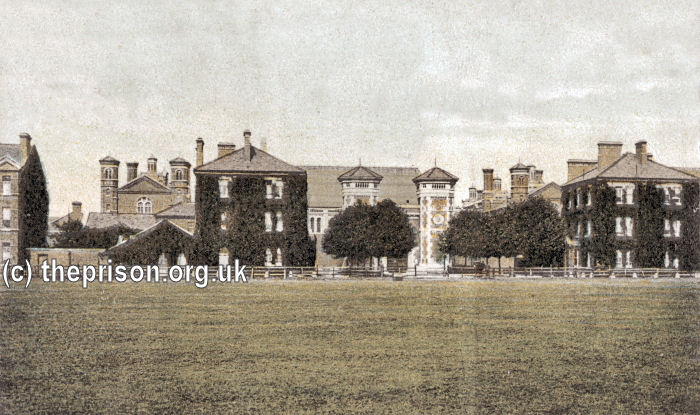
Wormwood Scrubs Prison from the south, London, c.1907. © Peter Higginbotham
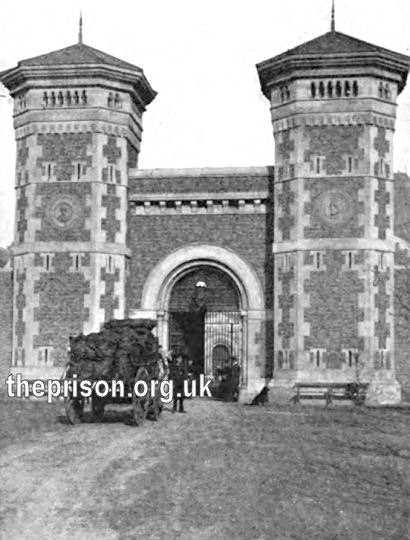
Wormwood Scrubs Prison - main gate, London, c.1895.
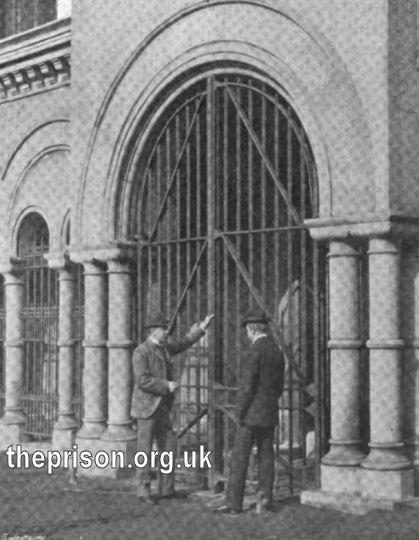
Wormwood Scrubs Prison - inner gate, London, c.1895.
In 1883, sufficient accommodation was available for Wormwood Scrubs to replace Millbank as a convict prison, while Millbank then became a local prison. In October 1890, when construction work at Wormwood Scrubs was finally complete, it was converted into a local prison, and Millbank was then closed. 'The Scrubs', as it was informally known, was used to confine male and female prisoners, including those serving short-term sentences, as well as some convicts during the earlier part of their penal servitude. Some of the female prisoners were accompanied by their infant children.
The inmates' daily routine is shown below:
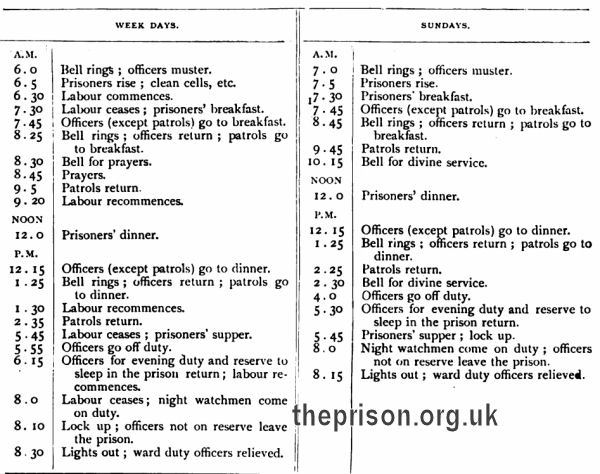
Wormwood Scrubs Prison - dinner delivery, London, c.1895.
At dinner time, the prisoners returned to their cells and the food was delivered to their doors.
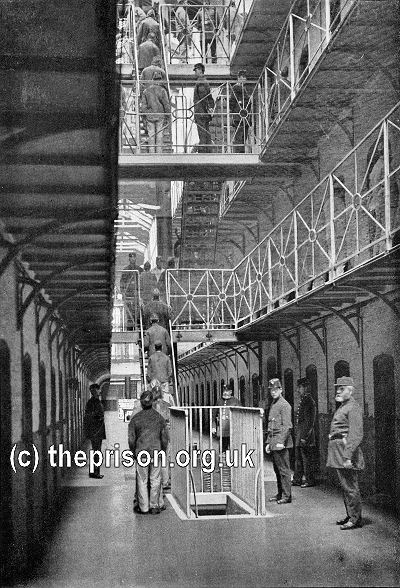
Wormwood Scrubs Prison - inmates returnimg to their cells for dinner, London, c.1898. © Peter Higginbotham
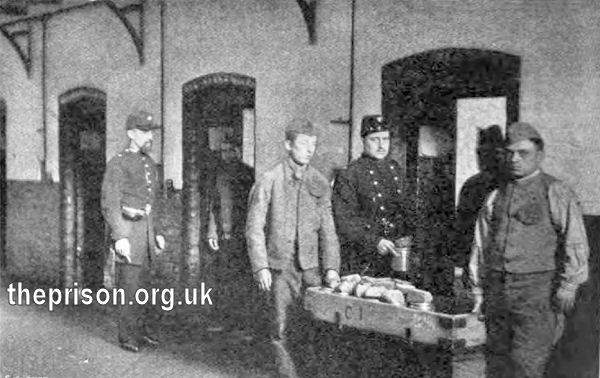
Wormwood Scrubs Prison - dinner delivery, London, c.1895.
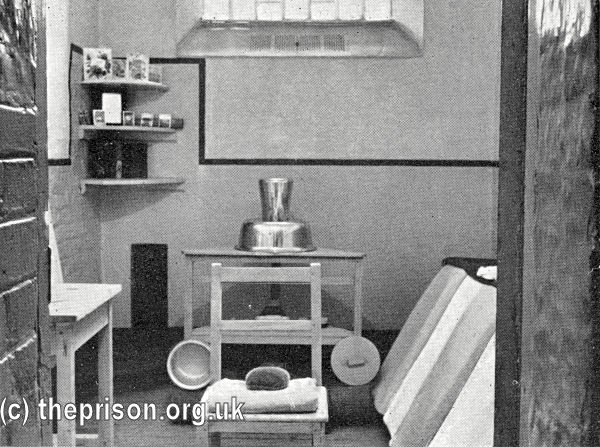
Wormwood Scrubs Prison - cell interior, London, c.1945. © Peter Higginbotham
The prison chapel accommodated 788 male and 202 female prisoners, plus 50 seats for officers in a gallery. Provision was also made for separate divine service for Roman Catholics.
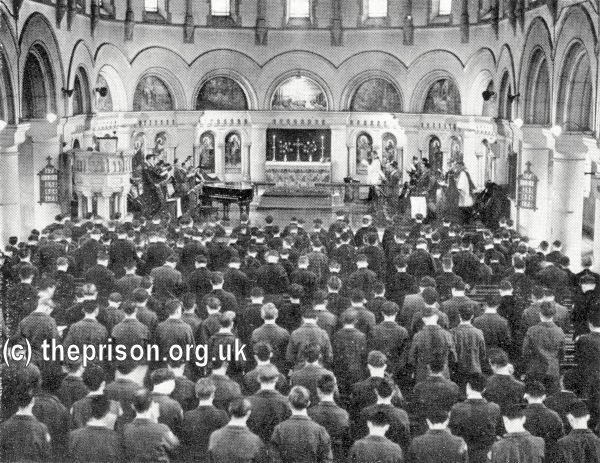
Wormwood Scrubs Prison chapel service, London, c.1945. © Peter Higginbotham
A wide range of work activities was carried out by the inmates. These included boot-making, post-bag making, mat making, basket-making, rope-making, oakum-picking, and the production of boxes for the Post Office, coal sacks for the Navy, bedding and blankets for the Army, and uniforms for prison officers. There were prison dressmakers, cutters-out, fitters, machine workers, milliners, cooks, bucklers, bookbinders, painters, white-washers, gardeners and cleaners.
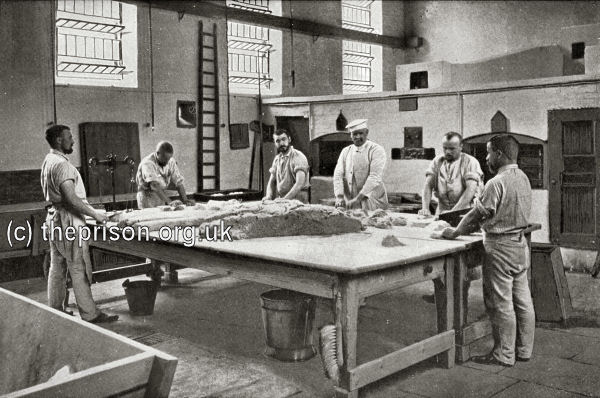
Wormwood Scrubs Prison bakery, London, c.1900. © Peter Higginbotham
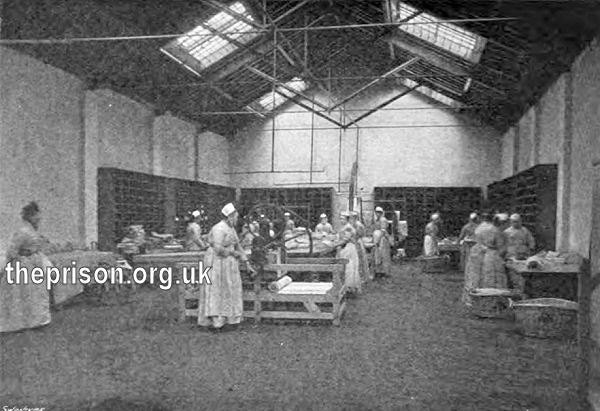
Wormwood Scrubs Prison - laundry, London, c.1895.
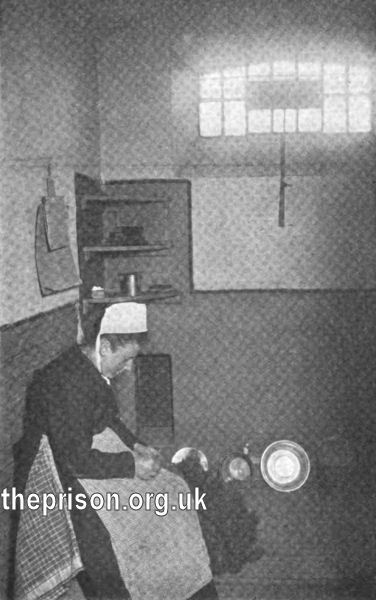
Wormwood Scrubs Prison - oakum picking, London, c.1895.
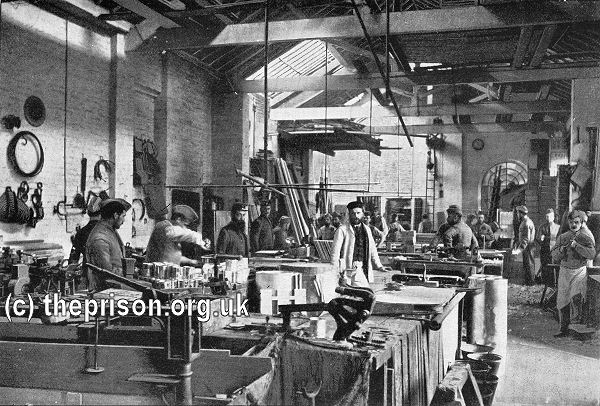
Wormwood Scrubs Prison mechanical shop, London, c.1898. © Peter Higginbotham
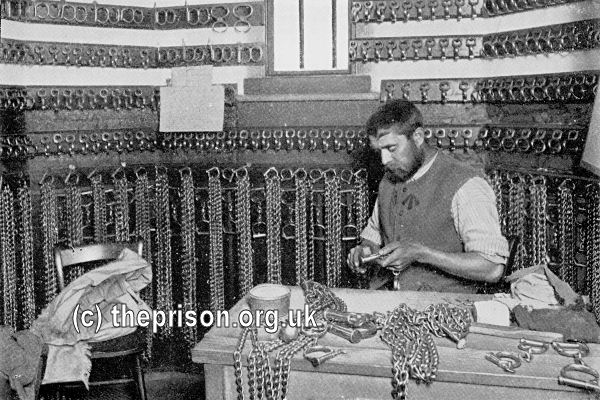
Wormwood Scrubs Prison handcuff and chain room, London, c.1900. © Peter Higginbotham
In 1902, the prison became a male-only establishment, with the existing female inmates being transferred to Holloway Prison.
During the Second World War, the prison was taken over by the War Department and the prisoners were evacuated to other prisons. The UK's internal security service, MI5, was based at the prison in 1939-40.
In the present day, HM Prison Wormwood Scrubs, is a Category B prison for adult males, sentenced or on remand from the local courts. The accommodation now comprises:
- A wing — remand and sentenced prisoners
- B wing — induction wing
- C wing — prisoners on an Intensive Drug Treatment Service
- D wing — high risk prisoner requiring single cells
- E wing — for prisoners attending Education
- Super enhanced wing — enhanced prisoners who are considered to be trustworthy
- Conibeere Unit — prisoners who require a substance misuse stabilisation regime
- First Night Centre — for prisoners during their first day(s) in custody
The cell blocks are Grade II listed, while the gatehouse has the higher Grade II* rating.
Records
Note: many repositories impose a closure period of up to 100 years for records identifying individuals. Before travelling a long distance, always check that the records you want to consult will be available.
- The National Archives, Kew, Richmond, Surrey, TW9 4DU. Holdings include: Indexes to working parties of prisoners (dates unknown); Registers of prisoners under separate confinement (1882-90).
- London Metropolitan Archives, 40 Northampton Road, London EC1R OHB. Holdings include: Nominal registers of prisoners (1917-61); Indexes (1952-67); Youth registers (1942-61); Indexes to youth registers (1951-59).
- Find My Past has digitized many of the National Archives' prison records, including prisoner-of-war records, plus a variety of local records including Manchester, York and Plymouth. More information.
- Prison-related records on
Ancestry UK
include Prison Commission Records, 1770-1951
, and local records from London, Swansea, Gloucesterhire and West Yorkshire. More information.
- The Genealogist also has a number of National Archives' prison records. More information.
Census
Bibliography
- Higginbotham, Peter The Prison Cookbook: A History of the English Prison and its Food (2010, The History Press)
- Brodie, A. Behind Bars - The Hidden Architecture of England's Prisons (2000, English Heritage)
- Brodie, A., Croom, J. & Davies, J.O. English Prisons: An Architectural History (2002, English Heritage)
- Harding, C., Hines, B., Ireland, R., Rawlings, P. Imprisonment in England and Wales (1985, Croom Helm)
- McConville, Sean A History of English Prison Administration: Volume I 1750-1877 (1981, Routledge & Kegan Paul)
- Morris, N. and Rothman, D.G. (eds.) The Oxfod History of the Prison (1997, OUP)
- Pugh R.B. Imprisonment in Medieval England (1968, CUP)
Links
- Prison Oracle - resources those involved in present-day UK prisons.
- GOV.UK - UK Government's information on sentencing, probation and support for families.
Except where indicated, this page () © Peter Higginbotham. Contents may not be reproduced without permission.



